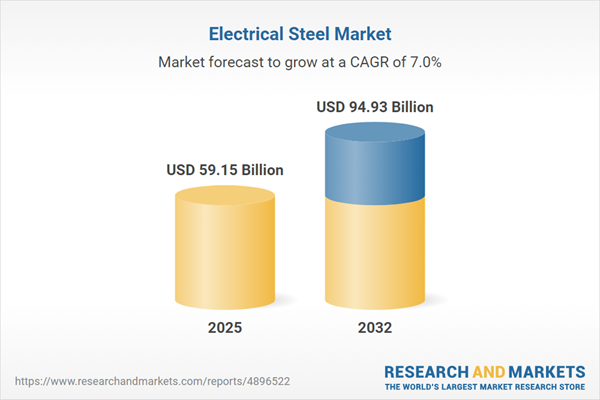Speak directly to the analyst to clarify any post sales queries you may have.
Senior decision-makers in the electrical steel market face a rapidly evolving business climate shaped by shifting global regulations, increased sustainability mandates, and accelerated technology rollouts. Staying ahead in this sector demands agile strategies, robust supply chains, and data-driven choices that ensure resilient and adaptive operations.
Market Snapshot: Electrical Steel Market Growth
The electrical steel market is entering a period of robust expansion due to strong infrastructure investment and the growing importance of energy efficiency in essential industries. In 2024, the market is valued at USD 55.23 billion and is projected to reach USD 94.93 billion by 2032, delivering a compound annual growth rate (CAGR) of 7%. This expansion is underpinned by several factors: increased industrial electrification, advances in power generation and distribution, and the integration of innovative electrical steel materials. As industries pursue electrification, electrical steel has become essential for electric mobility platforms, efficient automation environments, and reliable power networks, driving its critical role in the modernization of utility infrastructure and industry standards.
Scope & Segmentation of the Electrical Steel Market
This report equips executive teams with actionable market intelligence, enabling informed decisions about procurement strategies, technology investment, and competitive positioning across the entire value chain. The segmentation framework addresses key areas relevant to leadership:
- Product Types: Grain oriented electrical steel and non-grain oriented electrical steel, each optimized for high-demand magnetic functions in sectors such as transformers, automotive propulsion, and heavy industrial applications.
- Thickness Ranges: Choices extend from below 0.23 mm to above 0.40 mm, suitable for diverse use cases including electric vehicle propulsion systems, grid enhancements, and process automation, meeting varying operational requirements.
- Coating Types: Insulated and non-insulated versions are available in both organic and inorganic finishes, supporting longer lifecycle reliability and durable performance for critical infrastructure investments.
- Applications: Motors, transformers, generators, inductors, and chokes remain pivotal to industrial automation, stable electricity supply, and the continued adoption of e-mobility at a global scale.
- Regions: Americas, Europe, Middle East & Africa, and Asia-Pacific, each region introducing specific market drivers, policy contexts, and strategic procurement considerations for investment prioritization.
- Leading Companies: Nippon Steel Corporation, ThyssenKrupp AG, Aperam SA, JFE Steel Corporation, ArcelorMittal S.A., Posco Holdings Inc., NLMK Group, Tata Steel Limited, Voestalpine AG, and Mitsui & Co., Ltd. These firms collectively set standards and direct innovation within the competitive field.
- Technology and Collaboration: Advances in materials science and increased adoption of automation, paired with strategic partnerships, strengthen integration across the value chain and enhance readiness for evolving compliance requirements.
Key Takeaways for Senior Decision-Makers
- Deployment of advanced electrical steel grades supports operational flexibility and assists organizations in aligning with emerging energy efficiency goals and modernized grid requirements.
- Lifecycle assessments across sourcing and manufacturing procedures enable businesses to enhance compliance and demonstrate responsible environmental management practices.
- Securing access to premium materials and maintaining reliable partnerships help ensure stability across supply chains, reducing potential disruptions from shifting industry conditions.
- Automated and digitalized procurement workflows introduce higher process reliability, facilitating quality control and contributing to sustained operational improvements.
- Continuous regulatory monitoring allows executive teams to anticipate shifts in demand or policy, minimizing risk and fostering robust supplier networks.
- Coordinating automation initiatives with rigorous quality management frameworks assists organizations in quickly adapting to new compliance demands.
Tariff Impact: Navigating U.S. Trade Barriers
Current U.S. tariffs on imported electrical steel are encouraging domestic sourcing and increased investment in automation technologies. Strategic sourcing adjustments are necessary to preserve operational continuity and uphold competitive advantages as trade dynamics evolve.
Methodology & Data Sources
This report’s insights are drawn from executive interviews, in-depth analysis of technical literature, and a comprehensive examination of industry datasets. The methodology ensures recommendations are grounded in reliable and actionable information tailored for senior leadership.
Why This Electrical Steel Market Report Matters
- Enables executive teams to refine procurement strategies and direct technology investments for responsive and effective market actions.
- Facilitates the development of robust, compliant supply chains that align with changing sustainability and performance standards.
- Provides frameworks to strengthen business positioning and manage risk as market conditions and regulations continue to evolve.
Conclusion
This report offers senior executives strategic insights and practical guidance to support resilient operations, informed decisions, and sustained competitive strength in the progressing electrical steel sector.
Additional Product Information:
- Purchase of this report includes 1 year online access with quarterly updates.
- This report can be updated on request. Please contact our Customer Experience team using the Ask a Question widget on our website.
Table of Contents
3. Executive Summary
4. Market Overview
7. Cumulative Impact of Artificial Intelligence 2025
Companies Mentioned
The companies profiled in this Electrical Steel market report include:- Nippon Steel Corporation
- ThyssenKrupp AG
- Aperam SA
- JFE Steel Corporation
- ArcelorMittal S.A.
- Posco Holdings Inc.
- NLMK Group
- Tata Steel Limited
- Voestalpine AG
- Mitsui & Co., Ltd.
Table Information
| Report Attribute | Details |
|---|---|
| No. of Pages | 194 |
| Published | October 2025 |
| Forecast Period | 2025 - 2032 |
| Estimated Market Value ( USD | $ 59.15 Billion |
| Forecasted Market Value ( USD | $ 94.93 Billion |
| Compound Annual Growth Rate | 7.0% |
| Regions Covered | Global |
| No. of Companies Mentioned | 11 |









